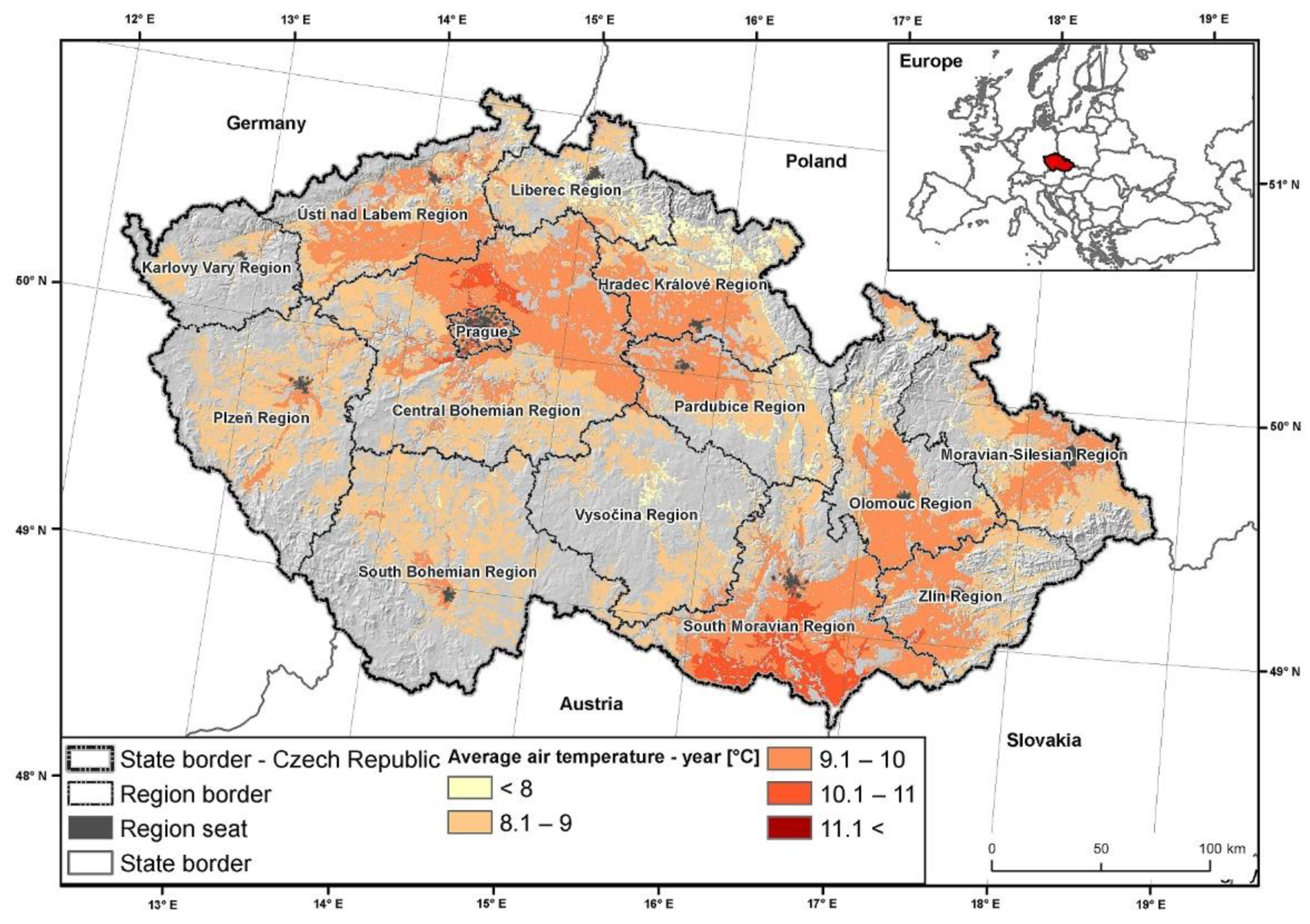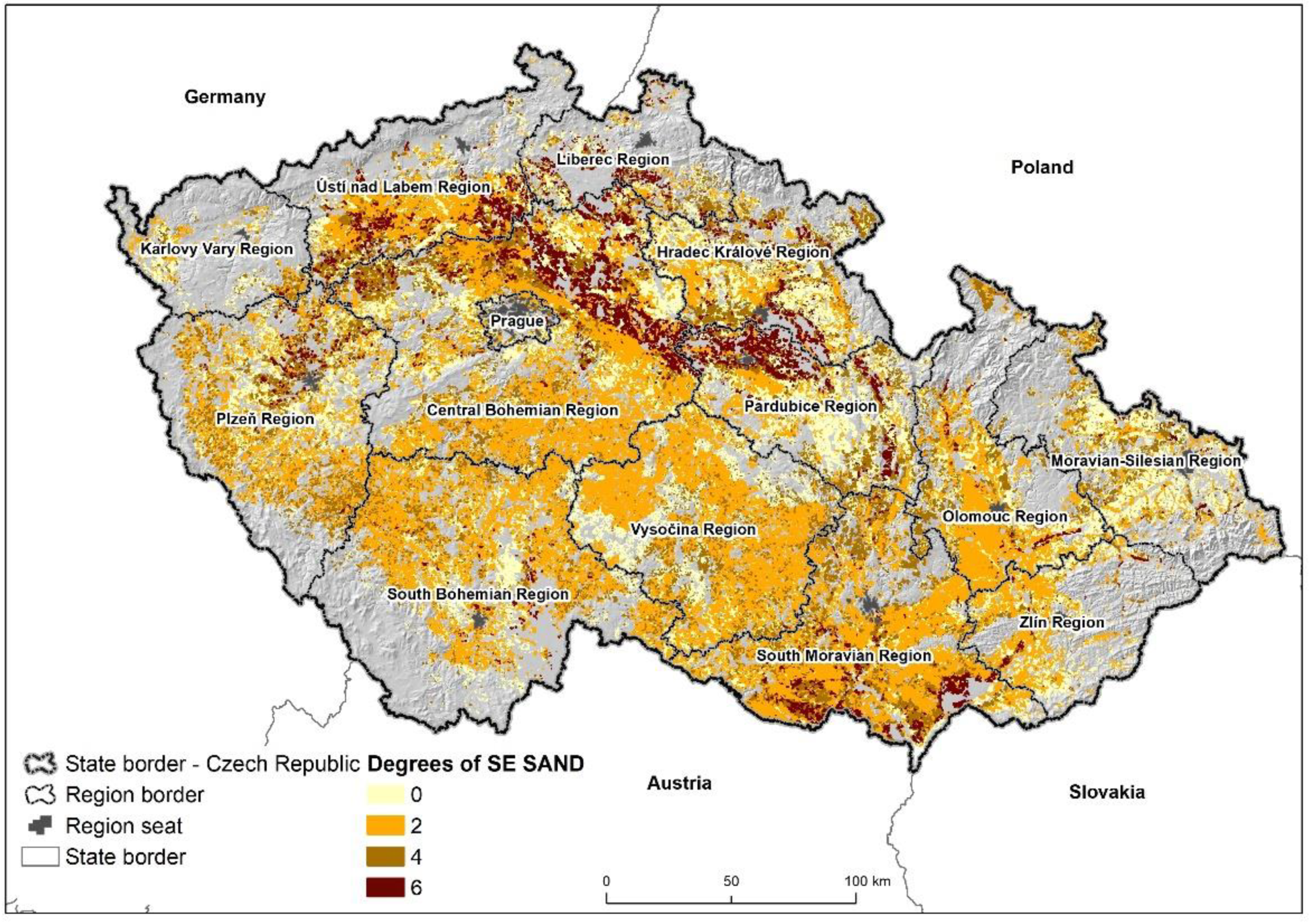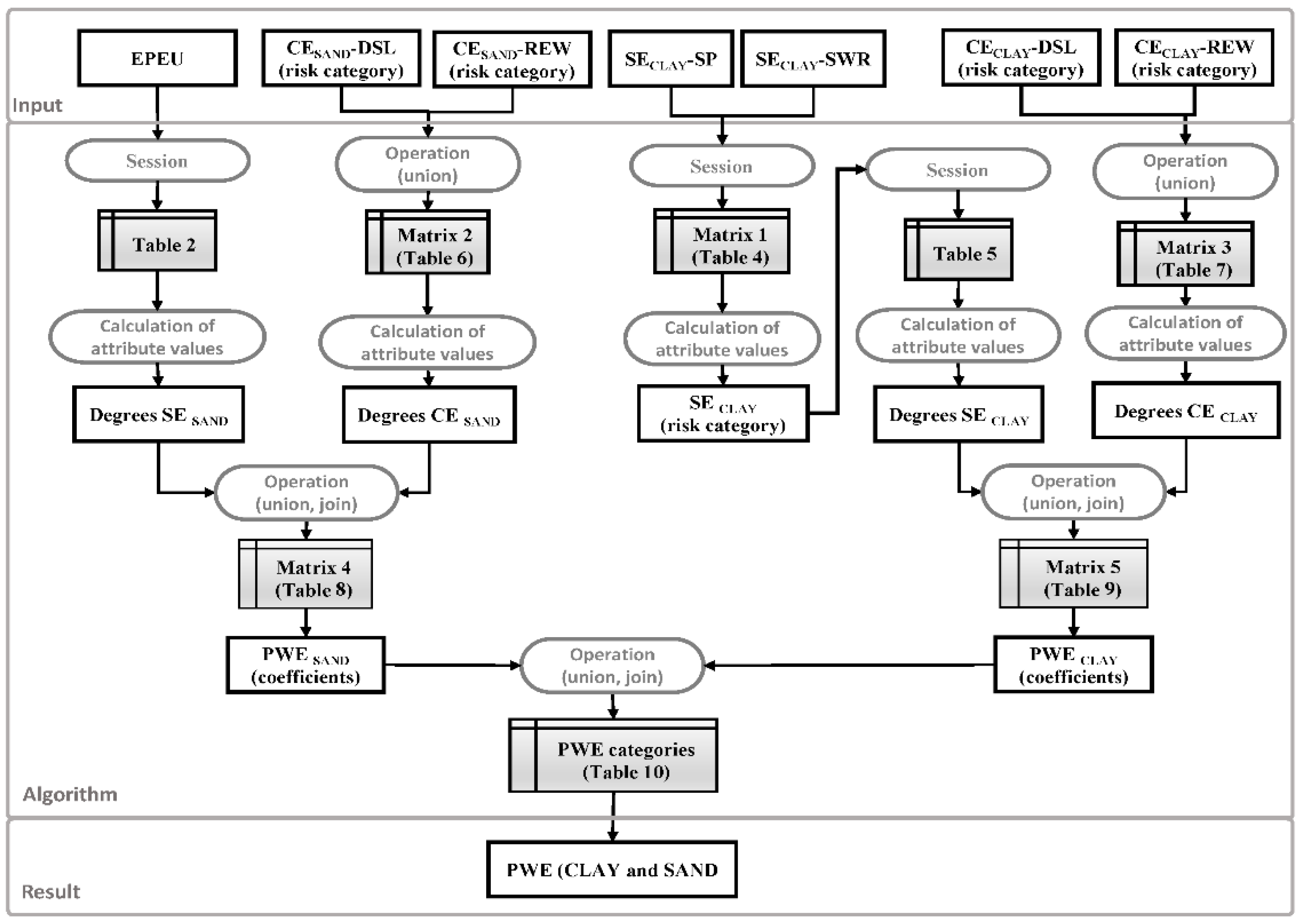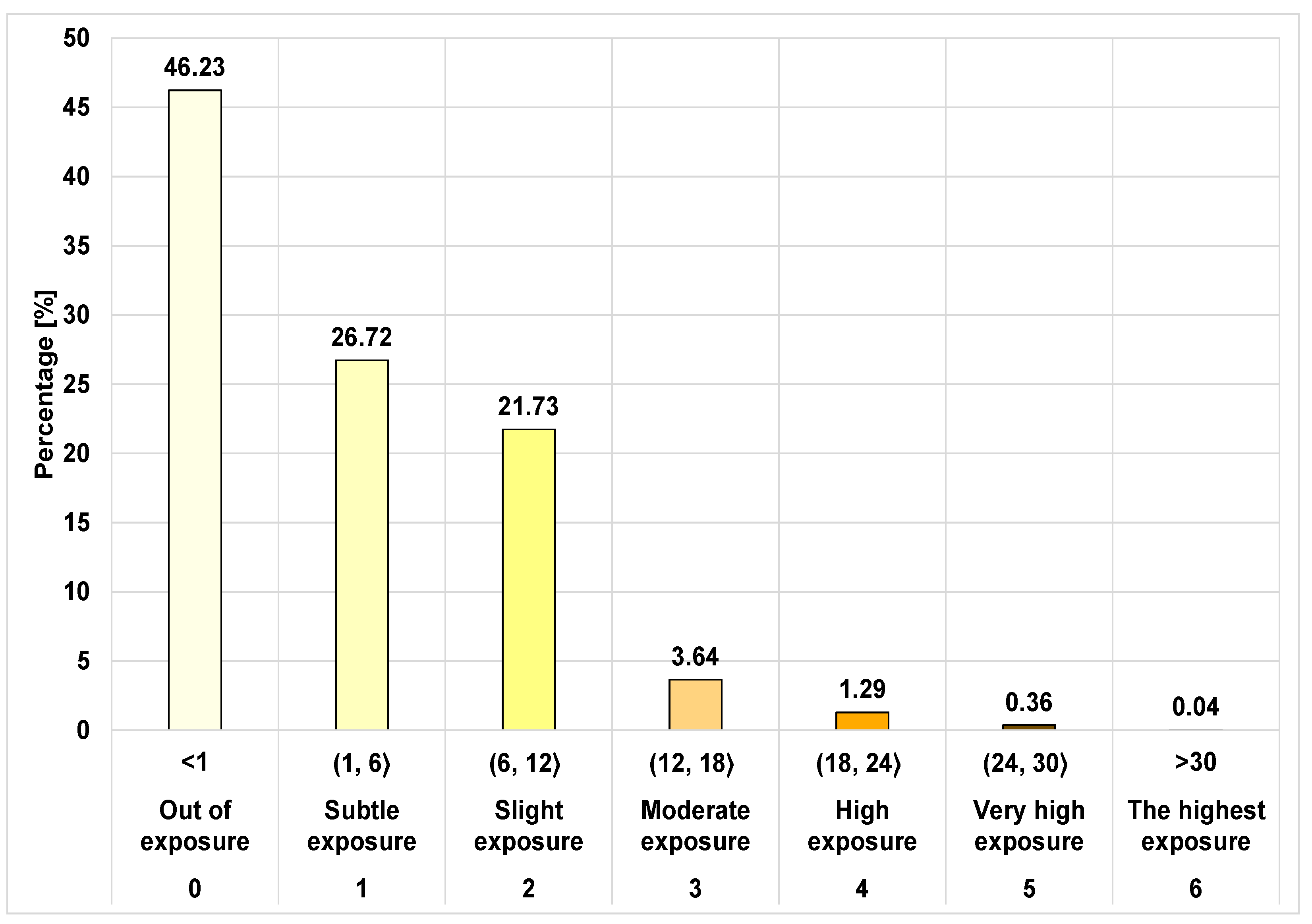2.2.1. Soil Erosivity (SE)
SE generally means the ability of a soil to resist wind forces. With a certain amount of generalization, we can follow the pattern of [
30,
31] and define SE as a combination of the wind-erodible fraction (EF) factor, soil-crust (SC) factor, vegetation-cover (VC) factor and surface-roughness (SR) factor.
The EF factor defined by [
32] is based on the soil’s texture and chemical properties, such as the content of sand, silt and clay and the content of organic-matter calcium carbonate, while [
33] simultaneously employed the clay and organic-matter content to obtain the SC factor.
We are fully aware that the mechanism of wind erosion differs with soil type. Across many studies (for instance [
34]), clay soils are not considered to be vulnerable to wind erosion. That is why they are not generally linked to any risk category in terms of the PWE. Some authors [
35,
36,
37,
38,
39,
40] claim that specific clay soils are highly vulnerable to the erosive effects of wind after winter under specific weather conditions. Notably, mainly clay soils show substantial annual changes in soil cohesion. Periodic freezing and thawing of the soil profile together with an enormous water content cause aggregate disintegration. The combination of particular soil properties with a specific winter regime makes clay soil vulnerable to wind erosion [
41].
In terms of the PWE estimation, we approached soil grouping with a certain measure of generalization. Soils with clay contents up to 45% were assigned as sandy-to-loam soils (throughout the whole paper, they were indexed as “SAND”). This category thus includes soils that have light texture, lighter to medium-heavy texture, and medium-heavy texture. That is, we include soils of sandy, loamy sand, sandy loam and loamy textures. The second group includes soils with a clay content above 45%, i.e., clay loam soils, clay soils and clay (hereafter indexed as “CLAY”). While speaking of sandy or clay soils, we indicate only that part of the soil profile that is directly exposed to climatic influence.
Nonetheless, the sandy soils generally evince a higher vulnerability to wind erosion than clay soil, so in terms of the SE degree, we assign them degrees of 2, 4 or 6, whereas clay soil is assigned degrees of 1, 3 or 5.
Soil erosivity of sandy soil (SESAND)
Lighter soils can generally be seen as having a higher proportion of macropores (lower overall porosity, larger mineral grains). These soils are typically characterized by higher aeration (hence, they are often more overheated than heavier soils) and better rainwater permeability. As they are not classified as medium-heavy soils, due to their low sorption capacity, they are often quite dry, showing a higher acidity and typically a lower content of mineral nutrients (and organic substances in general). Due to their predisposition, the lightest soils are very vulnerable to wind and water erosion. This susceptibility is because particles with a diameter of 0.05–0.08 mm (the boundary between dust and fine sand) are most easily transported by wind. According to the soil vulnerability factor, we differentiate the whole group according to
Table 1 in order to obtain Degrees of SE
SAND (
Table 2).
Case study on SESAND
The data source for soil properties was the national soil database “Estimated Pedological Ecological Unit” (EPEU) in the form of a five-digit code developed in the Czech Republic in the 1970s to evaluate the main pedological and climatological conditions of agricultural land from its production ability viewpoint. The EPEU could be successfully used for the estimation of wind-erosion risk in terms of the SE
SAND degree (
Figure 2).
Soil erosivity of clay soil (SECLAY)
Heavier soils are characterized by a lower proportion of macropores, thus showing lower water permeability for rainwater and overall aeration. If these soils accumulate rainwater at all, then due to high sorption capacity they lead poorly across the profile. As a result of all these phenomena, in heavier soils we encounter a double extreme; that is, in excess, the water concentrates on the soil surface and causes the site to become wet, and in the absence of water, hardening and cracking occur.
Some clay soils became vulnerable to wind erosion after they underwent the specific winter regime, which led to the creation of specific soil aggregates. The effects of moisture and temperature can cause significant changes in the aggregates and thus the erodibility of soil. Standardized methods allow aggregate-size distribution and aggregate stability, which affect wind erosion [
42]. Bullock (1988) [
43] measured the stability of soil aggregates throughout the year using wet sieving techniques. Major decreases in cohesion were found when the minimum daily air temperature fell to or below 0 °C during the winter and early spring months (caused by soil freezing at high water contents). Refs. [
41,
44] tried to identify the effects of freeze/thaw cycles and soil moisture on wind erosion with the help of wind-tunnel experiments. The surface-soil moisture content decreased in thawed soil and increased in frozen soil after wind erosion. The wind-driven sediment flow in the thawed soil was always greater than the flow of frozen soil with the same moisture content, but this difference became negligible at a moisture content above 3.38% (gravimetric moisture content) [
44].
According to [
41], the porosity of black soil with initial moisture contents on the surface of soil samples of 5–8% can increase by 1.4–1.5 times after the freeze/thaw process. The soil structure reaches a new stable state after 6 freeze/thaw cycles. The wind erosion increases with the number of freeze/thaw cycles. After 6–9 freeze/thaw cycles, the wind erosion of soil with moisture content of 5% and 7% increases by 1.2 and 2.0 times, respectively. The influence of freeze/thaw cycles on wind erosion is not significant when moisture exceeds 8%.
Therefore, in order to get SE
CLAY we defined soil potentially vulnerable to wind erosion (
Table 3) and following criteria of the specific winter regime, which are combined according to Matrix 1 in
Table 4):
- (a)
soil properties SE
CLAY-SP (
Table 1)
- (b)
specific winter regime SECLAY-SWR
- (i)
number of freeze–thaw and thaw–freeze episodes during the days without snow cover
- (ii)
number of days with wet soil surface, allowing soil aggregate dispersion
Individual degrees of SE
CLAY brings
Table 5.
Case study on SECLAY
The data source for soil properties was the national soil database EPEU. The data source for specific winter regime determination was the Czech Hydrometeorological Institute (CHMI) database, particularly the data on the “condition of bare soil surface” (CBSS) in combination with temperature data. The methodological approach to SE
CLAY is described in detail in [
45]. The SE
CLAY degree for the area of the case study is presented in
Figure 3.
Soil erosivity—vegetation cover factor (SEVC), soil surface roughness factor (SESR) and soil crust factor (SESC)
The SE
VC factor comprises two different dimensions. First, the protective effect of soil coverage (SE
VC-C)—mainly vegetation—and second, the protective effect of windbreaks (SE
VC-W)—mainly tree shelters. Borrelli (2016) [
46] and others expressed SE
VC-C by using the percentage of the surface covered with nonerodible plant material. SE
VC-W has often been based on optical porosity of windbreaks. The SE
SC factor affects wind erosion by dissipating the wind erosivity, while [
46] used a land cover map to derive the roughness length.
We integrated both SEVC (i.e., SEVC-C and SEVC-W), and SESR factors indirectly by choosing the relevant periods for CE, i.e., spring and autumn, which are characterized by:
- (i)
Little to no crop-vegetation cover and a flat and smooth soil surface with limited roughness (short before or after sowing).
- (ii)
Low protective effect of tree windbreaks. The optimal efficiency of the windbreak is mainly given by the optimal porosity (39%) and structure of the windbreak—multiple-row design [
47]. Ref. [
48] suggested that porosity between 40% and 50% is the most efficient. The highest values of optical porosity (up to 50%) are achieved in the nonvegetation period. Almost full foliage of windbreaks occurs in approximately 10 days in the spring. Autumn leaf fall lasts longer, and a gradual change in the optical porosity is longer.
- (iii)
With a tendency to be windier, according to [
29], the average wind velocity is increasing by 1–2 m s
−1 in the Czech Republic during these periods. It can be concluded that wind erosion is very intense at the beginning of spring, especially after the dry winter, and has a major impact on the regional agriculture.
SE
SC is relevant mainly to heavy textured soil “CLAY” and is reflected in their classification into the different risk categories in
Table 3 and
Table 5.
2.2.2. Climatic Erosivity (CE)
Kouchami-Sardoo (2019) [
49] developed a quantification of wind-erosion risk by incorporating the assessments of consequence and vulnerability. The model used was evaluated by scenario testing, sensitivity analysis, and wind tunnel measurements, which provided reasonable estimates of the soil vulnerability, consequence and risk to/of wind erosion. The results showed that weather factors were among the most important parameters affecting wind erosion risk.
CE is basically defined as a measure of the climatic tendency to produce conditions conducive to wind erosion. Ref. [
30] expressed the CE using the equation developed by [
50] employing the mean monthly wind speed (m s
−1) at a 2 m height and the potential evapotranspiration (mm) and the precipitation (mm). However, these are macroclimatic parameters that do not take into account the threshold wind speed and soil surface.
To obtain the CE degrees, we employed a complex approach that takes into account relevant climate variables, i.e., the drought in the surface layer (CE-DSL) and risk of erosive wind occurrence (CE-REW).
CE-DSL
Soils identified as vulnerable (see SE chapter) increase their susceptibility to wind erosion with the drought occurrence in their surface layer. In terms of wind erosion, the moisture of the soil surface is crucial mainly in the periods when the soil is uncovered by vegetation. Since the 1970s, remote sensing data have been of limited use for the purposes of assessing soil surface moisture [
51,
52]. For example, the successful use of the spatial resolution and frequency of imaging was not possible for the evaluation of soil-erosion hazards at the regional scale, especially when the land structure significantly differs. In those areas, it is worth applying data from sufficiently dense ground measurement networks of soil moisture if available.
CE-REW
Wind velocity is important for assessing wind erosion mainly in terms of the AWE. In this case, it is necessary to evaluate the actual wind velocity during a specific wind erosion event and relate it to real soil loss. In the case of the PWE, actual wind velocity is not taken into account, but average long-term wind conditions along with other parameters of SE and CE define the complex vulnerability of soil to wind erosion.
Wind direction and velocity measurements are normally performed 10 m above the surface. The wind speed required to initiate soil transport is referred to as the threshold wind speed (TWS). The TWS is a particularly important parameter but is difficult to determine it in wide-scale field studies. Most studies on the relationship between the particle size distribution of sediment and wind speed have focused on wind-tunnel experiments [
53,
54,
55,
56].
However, many factors that affect wind erosion and dust emission, e.g., clod structure, crusting, and soil shear strength, are difficult to simulate concurrently in a wind tunnel; thus, the results of wind-tunnel experiments cannot completely reflect the change in the particle-size distribution of sediment with wind speed [
57]. It is preferable to study the effect of wind speed on the particle-size distribution of sediment through field observations. However, it is difficult to completely collect and accurately determine the particle-size distribution of sediments at different wind speeds in the field [
58,
59]. The divergence in the erodibility for different sizes of particles at different wind speeds plays a critical role in changing the regularity of the aggregate-size distribution of windblown sediment with increasing wind speed.
The TWS varies with soil type. Based on wind-tunnel experiments, [
60] determined the TWC for various soil types (sandy, loamy–sandy, sandy–loamy and loamy) in dry and wet conditions (3.3 m s
−1 for sandy and 22 m s
−1 for loamy–sandy), with the lowest/critical value of 3.3 m s
−1. According to [
61], the TWS ranged from 8.0 m s
−1 to 22.0 m s
−1. For Hungarian soils (central Europe) on the basis of wind-tunnel experiments, [
62] stated the TWSs for soils with sand texture (5.7–8.1 m s
−1), loamy sand texture (6.1–9.1 m s
−1), sandy loam texture (7.4–9.8 m s
−1), loam texture (9.3–11.6 m s
−1) and silt loam texture (10.0–11.6 m s
−1). The wind data measured by weather stations at a height of 10 m can be easily interpolated to any height of 0 m to 10 m using models with the estimated parameters mentioned in [
63]. This study provides results that were used for the derivation of the wind speed at ground level. It can be derived that wind speeds of 10 m s
−1 and 10 m correspond to 3.3 m s
−1 at ground level.
Considering two principally different mechanisms of wind erosion due to different soil types, we again distinguish between CE of sandy soils (CESAND) and CE of clay soils (CECLAY).
Climatic erosivity of sandy soil (CESAND)
Sandy soils, identified as vulnerable (see the SESAND chapter), increase their susceptibility to wind erosion with drought in their surface layer. Contrary to clay soils, the SESAND of sandy soils is not affected by a specific winter regime but is simply given by their texture, i.e., the content of the EF in both seasons with low SEVC and SESC (spring and autumn) factors are taken into account in terms of the drought in the surface layer.
- (a)
Drought in the surface layer (CESAND-DSL)
Aware of the general comments on the CESAND, the spring and autumn periods were taken into account in terms of CESAND-DSL.
- (b)
Risk of the erosive-wind occurrence (CESAND-REW)
Considering the general comments on the CECLAY, only the spring period was taken into account in terms of the CESAND-REW.
The CE
SAND-DSL and CE
SAND-REW, when joined together according to Matrix 2 (
Table 6), reveal the degrees of CE
SAND.
Case study on CESAND
CESAND-DSL
To identify drought in the soil-surface layer, we employed CBSS data. This indicator is specified in [
45]. With respect to the spring and autumn vulnerability of sandy soils described above, CBSS data (code 0) from spring (March to May) and autumn (September to October) were employed for CE
SAND identification. CBSS code 0 is defined as: “soil surface is completely dry but not frozen; soil particles crumble to dust when squeezed, wind picks up dust from soil”. The long-term (30yr) average number of days with CBSS code 0 was calculated for 70 stations all over the area of interest. The area of interest was divided accordingly into 5 categories of the CE
SAND-DSL.
CESAND-REW
The risk of erosive winds in the spring and autumn was based on 10-min or 15-min wind speed data from 103 stations all over the area of interest for the longest possible (9 years) period in terms of data availability. The percentage of 10/15 min with a wind gust above 10 m s−1 of the total number of measurements (approx. 136,000 values for each station) was determined. The threshold value of the wind speed 10 m s−1 (measured at a height of 10 m above the surface) results from the conclusions of field measurements, when it was found that the ground wind speed is approximately one-third to one-half the wind speed at 10 m. A speed of 3.3 m s−1 is then the minimum towing speed for soil particles on dry light soil. The area of interest was divided accordingly into 5 categories of CESAND-REW.
The CE
SAND degree for the area of the case study is presented in
Figure 4.
Climatic erosivity of clay soil (CECLAY)
In terms of the mechanism, CECLAY is analogous to CESAND with one modification. CECLAY deals with critical period determination. Due to the specific winter regime, which invokes the creation of aggregates removable by wind, the critical period for clay soils in terms of the drought occurrence is mainly early spring. In the spring months, these soils show considerable potential erodibility due to the disintegration of aggregates in the winter, while in the autumn they tend to be mostly compact, and unless they are damaged by inappropriate cultivation they are almost invulnerable to wind erosion. Therefore, only spring droughts were taken into account.
- (a)
Drought in the surface layer (CECLAY-DSL)
Aware of the general comments on CECLAY, only the spring period was taken into account in terms of the CECLAY-DSL.
- (b)
Risk of the erosive wind occurrence (CECLAY-REW)
Considering the general comments on CECLAY, only the spring period was taken into account in terms of the CECLAY-REW.
“Drought in surface layer” and “Risk of erosive wind occurrence” when joined together according to Matrix 2 (
Table 6) reveal the degrees of CE
CLAY (
Table 7).
Case study on CECLAY
CECLAY-DSL and CECLAY-REW were estimated analogically to CESAND-DSL and CESAND-REW. However, with respect to the general definition of CECLAY, only data from the spring period were used.
The CE
CLAY degrees for the area of the case study are presented in
Figure 5.














